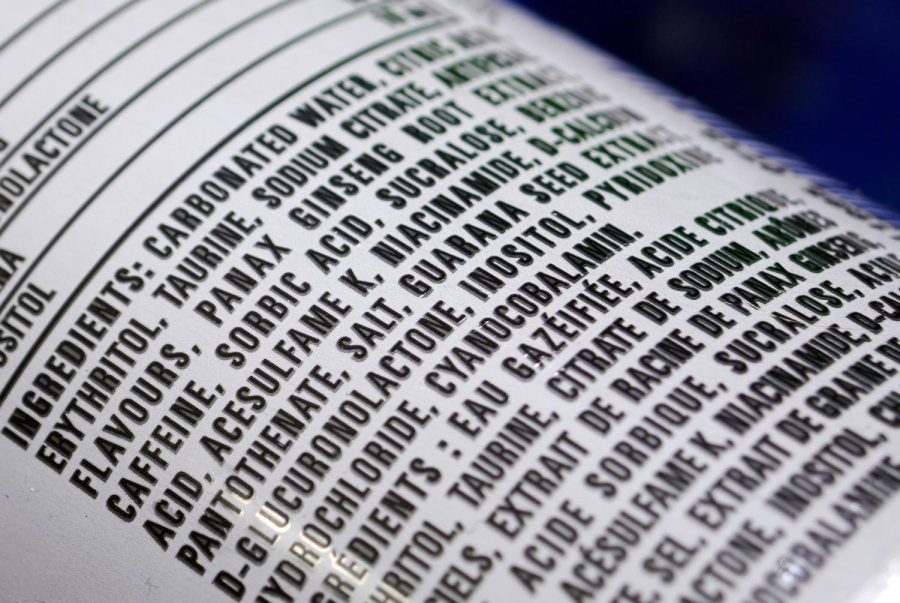Students should read the ingredients in packaged foods
Getty Images
A list of ingredients in a drink, including food coloring, sugars, preservatives, artificial flavors and more. Senior Columnist Angelina Padilla-Tompkins urges students to pay more attention to their food and drink ingredients.
April 26, 2023
We all know health matters, but as a student, it is challenging to determine where to start.
It is essential to prioritize healthy eating habits because simply focusing on your diet can increase an individual’s quality of life immensely. The early 2000s had the “Got Milk?” campaign and the “MyPlate” example of what the government claimed a healthy plate should look like. Even with those examples, forming healthy habits can be a challenge.
“People with healthy eating patterns live longer and are at lower risk for serious health problems such as heart disease, type 2 diabetes and obesity. For people with chronic diseases, healthy eating can help manage these conditions and prevent complications,” explained the CDC.
It can be hard to eat healthy, but a great place to start is by simply turning the can or the box over and reading the ingredients.
Reading the ingredients in your favorite packaged food or beverage can help you better understand what is in the product, and thus what you are putting in your body.
Julie Patterson, assistant professor in nutrition, dietetics and wellness, explained that one essential part of eating better is by focusing on the entire food label.
“Most people just focus on the top part of the label, which is the fats and sugars, the heavy hitters of what our macronutrients are, and people tend to not look at the daily values as much,” Patterson said. “The daily values are based on a 2,000-calorie diet. So, for kids in particular, that may not be consuming a 2,000 calorie diet, then looking at the percent daily value on the label is going to mean that, based on their needs, they’re getting even more.”
A perfect example of a single product meeting or going over the percent daily value is the PRIME energy drink.
“(In PRIME) the ingredients that were surprising to me was the amount of vitamin A specifically and vitamin E,” Patterson said.
The whole point of a supplement is to make up for what might be lacking in a single meal, it is not supposed to meet 100% of a person’s needs. If a single product is designed to meet an individual’s needs completely, then that is considered a meal replacement.
What is shocking about the Prime energy drink is that vitamin A and vitamin E meet 100% of the daily value.
“We need vitamin A, right? There’s benefits to it, but 100% of vitamin A in one drink, and 100% of vitamin E in one drink is essentially telling the public that we don’t think you’re having vitamin A from any other source, so we’re gonna put 100% of your needs in this one bottle people are drinking like water,” Patterson said.
When an individual drinks too much vitamin A over a long period of time, they could experience acute vitamin A toxicity, or hypervitaminosis A.
“Acute vitamin A toxicity, also referred to as hypervitaminosis A, occurs within days to weeks after someone ingests one or a few very high doses (typically more than 100 times the RDA). Resulting signs and symptoms typically include severe headache, blurred vision, nausea, dizziness, aching muscles, and coordination problems. In severe cases, cerebral spinal fluid pressure can increase, leading to drowsiness and, eventually, coma and even death,” according to the National Institutes of Health.
Students should be cautious when grabbing their next energy drink as they cram for finals, try reading the ingredients first. A good rule of thumb: If you can’t read it, don’t eat it.
Additionally, the energy drink Celsius is in the middle of a lawsuit as well for advertising “no preservatives” in their drink when each includes citric acid, reported CBS.
Citric acid is an extremely common preservative used in most carbonated drinks, so it makes sense that it would be used in the Celsius drinks, but it does mean that the labeling is wrong when claiming there are “no preservatives.”
While citric acid is not bad for the human body, the Celsius case is a great example of why individuals must read food and drink labels before ingesting them.
As a student, prioritizing healthy eating habits can be challenging. Students are constantly rushing to work or class and trying to complete homework. All that stress is precisely why they need to at least try to build a good foundation for healthier eating habits.
The best way to ensure a healthier diet is to ensure you are the one in control and not the food industry.
“Shopping the perimeter of the grocery store gives you more control, sight because when you shop the perimeter of the grocery store you are selecting individual ingredients, such as whole fruits and vegetables,” Patterson said. “I am getting this orange, and this orange was not tampered with in any way.”
One argument against purchasing fresh fruits and vegetables is that it’s not always budget-friendly and the products go bad quickly. However, Patterson recommends purchasing frozen produce instead.
“I think that to help produce last longer you could consider buying frozen produce and that way you can use it as you need it,” Patterson said.
Additionally, for students on a budget, Aldi is a great place to find healthier options at a lower price.
“I am a huge fan of Aldi. I love Aldi, they have the most beautiful produce there. You know, it’s like in terms of the price point it’s much lower than I’ve seen it at other grocery stores,” Patterson said.
It is understandable for students to want to eat out occasionally, or purchase packaged food because it is easier to throw a frozen meal in the microwave for five minutes than to simply add water and stir. However, students need to be mindful of the ingredients in the foods they consume.
“I would never expect students to not consume any foods that are prepackaged. I just want to empower consumers to take a moment to look at something, if you can’t pronounce an ingredient on the ingredient list, you probably shouldn’t eat it,” Patterson said.
Eating healthier as a student can seem like a huge challenge, but if you start by taking a few seconds to turn the package around and read the ingredients, you will be headed in the right direction.







